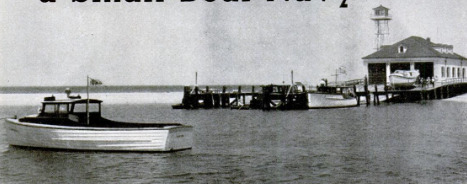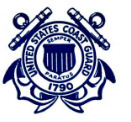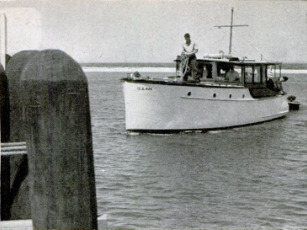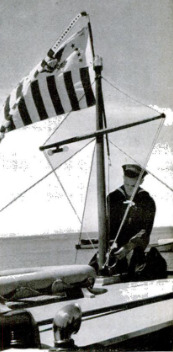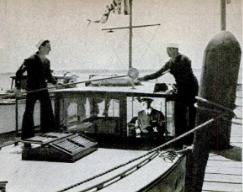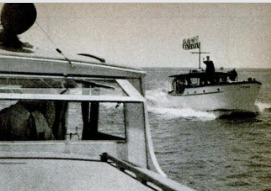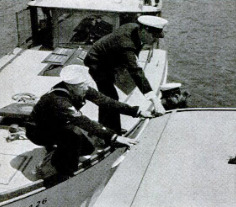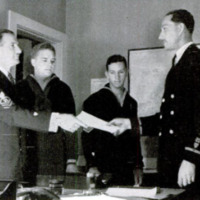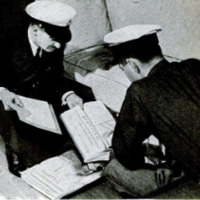-
Title (Dublin Core)
-
Coast guard mobilizes a small boat navy
-
Article Title and/or Image Caption (Dublin Core)
-
Title: Coast guard mobilizes a small boat navy
-
extracted text (Extract Text)
-
AMERICA'S booming luxury sport of mo-
torboating and its $100,000,000-a-year
small-boat industry find themselves at the
very heart of one of the most important ex-
pansions in the national defense effort. The
United States Coast Guard, the military
service which up to now has carried the
brunt of this country’s direct contacts with
the new world war, has set out to build up a
reserve force by drawing upon the skills
of the amateur yachtsmen and fishing-boat
skippers of our coasts and inland water-
ways. The vast flotilla of motor cruisers in
the yacht basins of tidewater, which has
increased so rapidly during the last decade,
now becomes a reservoir of picket boats for
keeping watch over the 40,000 miles of
shore line which are the ramparts of the
United States.
The navigation of big ships at sea and
the handling of small vessels in coastal wa-
ters are two different skills. Officers of the
merchant marine are being grabbed up
rapidly by the Navy, which within a few
years will have the problem of manning a
two-ocean fleet. Meanwhile the Coast Guard
is concentrating on its friends, the yachts-
men, whose knowledge of seamanship, navi-
gation, and gas engines, plus familiarity with
local waters and boatmen, makes a national-
defense asset immediately convertible to a
useful purpose. These men would be green-
horns aboard a battle-wagon, but along the
line of their own hobby, many of them are
extremely good. And so are thelr boats.
Ever since the evacuation of the British
army from Dunkirk, accomplished largely
by England's fishing and yachting fleets, the
value of small boats in military operations
has needed little sales talk. Professional na-
val men, of course, have recognized it all
along. In every year's maneuvers in the
Caribbean, the fleét has taken along a hun-
dred of the Coast Guard's surfmen, whose
skill on the beaches is of tremendous im-
portance for such operations as the landing
of marines.
Such needs spring up In unexpected
places. Right now, the most immediate
value of the Coast Guard's mew reserve
fleet is not on the seacoast at all, but in the
upland reaches of the Tennessee River.
Building the dams of the Tennessee Valley
Authority created great inland lakes, upon
which immediately sprang up large fleets of
motorboats. The Coast Guard did not have
the equipment to police these waters, though
obviously the presence of a swarm of un-
supervised craft presented grave danger of
sabotage against electric power. Local re-
serves, familiar with local boats and boat-
men, were able to take over guard duty
more efficiently than any Coast Guard reg-
ulars imported for the purpose from salt water.
This country has 300,000 power boats in Fed-
eral waters, and they have been increasing at the
rate of more than 35,000 a year. Those figures do
not include the boats on intrastate lakes, or the
150,000 outboard motors which go into service
each year on inland waters.
The job of mobilizing a small-boat navy, se-
lected from the best of these 300,000 units, was
started by the Coast Guard two years ago, under
authority of the Coast Guard Reserve Act of
1939. That was a very innocuous law, specifically
nonmilitary in purpose, which provided that
yachts and commercial fishing boats might be or-
ganized into flotillas of “reserves” for the purpose
of study of seamanship and the promotion of
safety. It was provided that the Coast Guard
might borrow the reserve boats for rescue mis-
sions and the patrolling of regattas. There were
repeated announcements that all this had nothing
to do with national defense plans, but the
yachtsmen knew better. They nodded, and
Joined up.
By the end of the yachting season of 1040
the Const Guard Reserve numbered 3,000
members, organized in 150 flotillas with
2,700 boats. The number might have been
much larger, but the officers in charge pre-
ferred that ‘the organization grow slowly
and tightly, with high standards.
Then they were ready for serious busi.
‘ness, made possible by the Coast Guard Re-
serve Act of 1041, passed last February.
This law abolished the old “reserve” and set
up an actual military reserve, under which
officers and men have been commissioned
and enlisted, and sent to sea for active duty.
Tn place of the old Reserve, the new law
created the Const Guard Auxiliary, roughly
the equivalent of the 1040 Reserve, but a
more serious matter. Under the new law
any of the thirteen District Commanders
of the Coast Guard may call on Auxiliary
boats that have been voluntarily offered for
temporary active service, for any purpose
he may deem desirable, enlisting the owner
and his crew as temporary members of the
reserve on active duty, under command of a
regular Const Guard officer.
The yachtsmen went for it like flies for
molasses. Under this plan the owner of a
motor cruiser could sign on a crew of like-
minded friends, then enlist the boat and
crew for active duty. The Government pays
no rent for much a boat, but it pays all
maintenance and running expenses and as
long as the boat remains in service the
Coast Guard provides uniforms and regular
enlisted men's pay to the crew. If In service
for three months or more, the skipper may
be commissioned as an ensign or lieutenant
(junior grade).
These temporary enlistments mean that
a large number of yachtsmen are receiving
invaluable training, this summer, in their
own boats, in the duties of patrol and law
enforcement which they might be called
upon to assume if actual war should call off
much of the regular Coast Guard.
The program for this summer called for
the immediate commissioning in the Reserve
of 100 commissioned officers and 126 war-
rant officers for sea duty on regular cutters,
and for the use of 270 boats from the
Auxiliary with six enlisted men each. This
would provide 1,620 enlisted men for reserve
service at one time, but because the enlist-
ments are temporary, it is providing train-
ing for a much larger number.
While 270 boats does not seem like many
in wartime terms of thought, they are a
large addition to the Coast Guard's peace-
time strength of 267 cutters (72 feet or
more) and 199 picket boats. These boats
are predominantly in a class with the
smaller picket boats, ranging from 30 to 40
feet. This country had many larger yachts.
of high-speed, sea-going caliber, but most
of these have been bought up by the British
or the United States Navy. By last spring
nearly 100 of America’s most luxurious
yachts had gone into service with the British.
The small boats are being used mainly
for harbor work, releasing the larger,
tougher Coast Guard vessels for duty out-
side. Inevitably, if war should come, the
routine work of patrol will have to be done
by smaller vessels than in the past, for the
larger units will be called for combatant
duty. Already, under the lend-lease law,
President Roosevelt has transferred to the
British the Coast Guard's ten 250-foot cut-
ters of the “lake” class—stout, fast vessels
which had been heavily armed and other-
‘wise prepared for warfare. That was a hard
blow to the Coast Guardsmen, who prized
these little ships highly, and hardly expect
to see their like again. Worse, their seven
327-foot. cutters have been taken over by
the Navy. as well as some smaller craft.
‘The Coast Guard, with a military estab-
lishment rapidly increasing through enlist-
ments toward a goal of 25,000 men, is an
extremely important adjunct of American
defense. It is a part of the Treasury De-
partment, but automatically upon declara-
tion of war, or by order of the President in
an emergency, it becomes part of the Navy.
Its network of radio, telephone, and cable
communications covering the whole coast
line, its hundreds of surfboat and patrol
stations, its ten air bases, its boat-building
yards, its lighthouses and lightships, all are
of immense importance for defense; but
functionally they are geared more for peace
than for war. The Coast Guard's 55 air-
planes, for instance, are of almost no mili-
tary significance, except perhaps as recon-
naissance units; but its 65 aviators are all
competent military flyers, trained in the
Navy's Pensacola school. During the World
War more than a third of the Coast Guard's
line officers were put in command of com-
bat ships; and in the 1040's, when the ships
are ready, men of equal caliber will be
ready to take them over.
A 'yachtsman who is on active duty with
the Coast Guard is of course exempt from
other military service, but it would be a
great mistake for anybody to sign up with
the idea the service is anything like the
home guard. The Coast Guard lost a bigger
percentage of its officers and men in combat
in the World War than did either the Army
or Navy. The service, going back to the
Revenue Marine founded by Alexander
Hamilton, has as fine a tradition as any
military outfit in the country.
During the present emergency, while the
Army and Navy have concentrated on build-
ing up their striking power, the Coast
Guard has been the handy man of national
policy. When President Roosevelt decided
to seize the German, Italian, and Danish
ships in American harbors, the Coast Guard
did the job. Every major American harbor
is today under the command of a Coast
Guard captain of the port, who rules all
anchorage and movement of ships, keeps
rigid control over all loading of explosives,
guards against sabotage. For nearly a
year before the President declared an
‘American protectorate over Greenland last
spring, Coast Guard cutters had patrolled
the Greenland coasts, cultivated the friend
ship of the local population, watched for
signs of Nazi activity. At Lisbon, America’s
one remaining point of direct contact with
Europe, a Coast Guard cutter stands by to
represent the flag.
Even if all the job he gets is running a
patrol boat in his home-town harbor, the
man skilled with small boats will find no
better line of service than the Coast. Guard.
Should war come there is little likelihood
that our coast line will remain as immune
as it was in the last war, and even then it
was not unscarred. One maritime hero of
the last fray was the skipper of the Dia-
mond Shoals Lightship, who was spending
his life anchored off Cape Hatteras. Ob-
serving a German submarine operating in
the vicinity, he sent out a radio warning to
near-by ships. Cheated of its prey, the sub-
marine turned around and sank the light-
ship. The chance to be a hero ls like
lightning. You never can tell where it will
strike.
-
Contributor (Dublin Core)
-
Hickman Powell (article writer)
-
Language (Dublin Core)
-
Eng
-
Date Issued (Dublin Core)
-
1941-09
-
pages (Bibliographic Ontology)
-
76-79
-
Rights (Dublin Core)
-
Public domain
-
Archived by (Dublin Core)
-
Sami Akbiyik
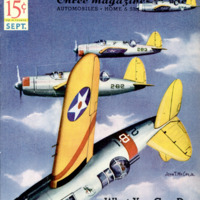 Popular Science Monthly, v. 139, n. 3, 1941
Popular Science Monthly, v. 139, n. 3, 1941

